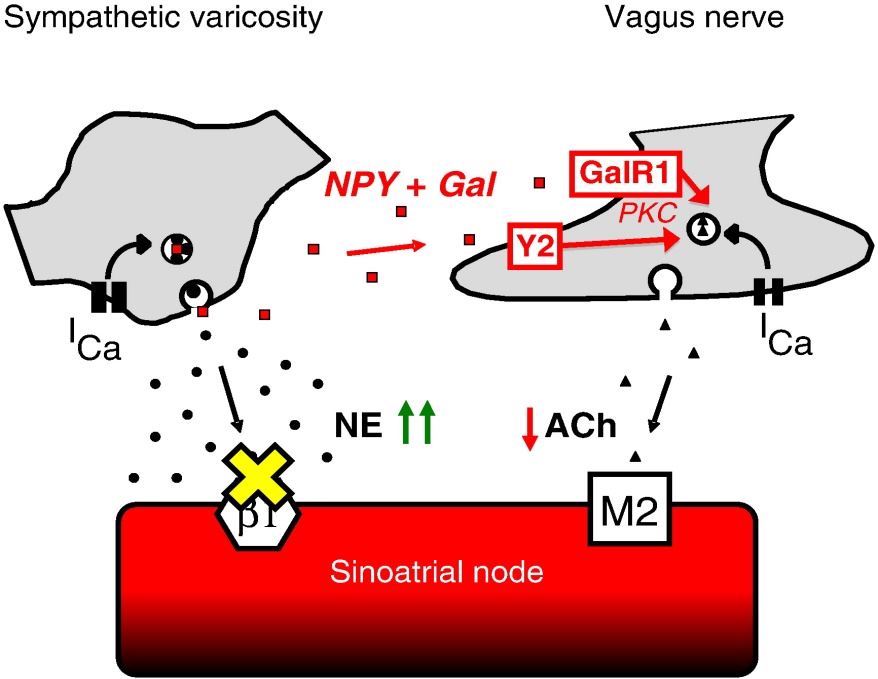Introduction of GALR1
The human GalR1 receptor was cloned from a human Bowes melanoma cell line in 1994 and contains 349 amino acid residues whose coding gene is located on the chromosome at 18q23. This gene contains at least two introns. Exon 1 encoding from the N-terminus to the end of the fifth transmembrane segment, exon 2 encodes the third intracellular loop, and exon 3 encodes the sixth transmembrane fragment to the C-terminus. Human GalR1 receptor and human GalR2 receptor, GalR3 receptors and somatostatin share certain homology with opioid receptors. The human and rat GalR1 receptors are approximately 92% homologous. The two N-linked glycosylation sites and intracellular phosphorylation sites are consistent. There are 7 sites for the action of phosphokinase A (PKA) and phosphokinase C (PKC) in the second and third intracellular loops, but the human GalR1 receptor is on its C-terminus. There are 2 phosphorylation sites on the domain.
| Basic Information of GALR1 | |
| Protein Name | Galanin receptor type 1 |
| Gene Name | GALR1 |
| Aliases | GALNR, GALNR1, Galanin receptor 1 |
| Organism | Homo sapiens (Human) |
| UniProt ID | P47211 |
| Transmembrane Times | 7 |
| Length (aa) | 349 |
| Sequence |
MELAVGNLSEGNASWPEPPAPEPGPLFGIGVENFVTLVVFGLIFALGVLGNSLVITVLARSKPGKPRSTTNLFILNL SIADLAYLLFCIPFQATVYALPTWVLGAFICKFIHYFFTVSMLVSIFTLAAMSVDRYVAIVHSRRSSSLRVSRNALL GVGCIWALSIAMASPVAYHQGLFHPRASNQTFCWEQWPDPRHKKAYVVCTFVFGYLLPLLLICFCYAKVLNHLHKKL KNMSKKSEASKKKTAQTVLVVVVVFGISWLPHHIIHLWAEFGVFPLTPASFLFRITAHCLAYSNSSVNPIIYAFLSE NFRKAYKQVFKCHIRKDSHLSDTKESKSRIDTPPSTNCTHV |
Function of GALR1 Membrane Protein
In the inflammatory state, the GalR1 receptor may be regulated by the transcription factor NF-κB. A cells (a cell line similar to the blue spot) all can result in up-regulation of GalR1 mRNA. Forskolin's regulation of GalR1 mRNA appears to be mediated by the binding of the cAMP response element binding factor (CREB) to the CRE site of the GalR1 receptor promoter. The GalR1 receptor is coupled to the Gi/o protein, and the function of the cells is mainly inhibited. GalR1 receptors are activated to reduce the efficiency of synaptic transmission, thereby affecting many physiological processes such as ingestion, mood, memory, pain transmission, intestinal secretion, and exercise.
 Fig.1 GalR1 receptor signaling directly or indirectly involves protein kinase C (PKC).
Fig.1 GalR1 receptor signaling directly or indirectly involves protein kinase C (PKC).
Application of GALR1 Membrane Protein in Literature
This article reports that exogenous GAL protects the brain from ischemic injury by inhibiting Capasase-8/12-induced apoptosis and may be mediated by GalR1 through the cPKCγ signaling pathway.
This article reveals that the methylation of GAL, GALR1 or GALR2 correlated most closely with the poor survival rate of patients with HPV-negative oropharyngeal cancer. Therefore, GAL and GALR 1/2 methylation status can serve as important site-specific biomarkers for predicting clinical outcome in HNSCC patients.
The article reveals that galanin has an anti-diabetic effect. Studies have shown that administration of galanin can relieve insulin resistance by promoting the expression and translocation of glucose transporter 4 (GLUT4) in rat skeletal muscle.
This article shows that GAL and its receptors play a role in HNSCC tumorigenesis. Therefore, GAL and GALR1/2 methylation status can serve as important biomarkers for clinical outcome.
This article evaluates that pyrosequencing methylation analysis of the GALR1 promoter can be a useful cytological marker that may help better manage women with endometrial lesions and ultimately reduce unnecessary interventions.
GALR1 Preparation Options
To obtain the soluble and functional target protein, the versatile Magic™ membrane protein production platform in Creative Biolabs enables many flexible options, from which you can always find a better match for your particular project. Aided by our versatile Magic™ anti-membrane protein antibody discovery platform, we also provide customized anti-GALR1 antibody development services.
As a forward-looking research institute as well as a leading customer service provider in the field of membrane protein, Creative Biolabs has won good reputation among our worldwide customers for successfully accomplishing numerous challenging projects including generation of many functional membrane proteins. Please feel free to contact us for more information.
Reference
All listed services and products are For Research Use Only. Do Not use in any diagnostic or therapeutic applications.